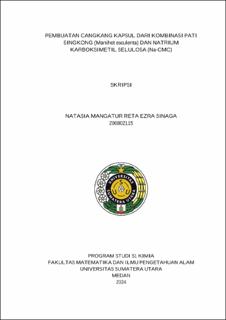Pembuatan Cangkang Kapsul dari Kombinasi Pati Singkong (Manihot Esculenta) dan Natrium Karboksimetil Selulosa (Na-CMC)
Making of Capsul Shell from Combination of Cassavastarch (Manihot Esculenta) and Sodium Carboxymethyl Cellulose (Na-CMC)

Date
2024Author
Sinaga, Natasia Mangatur Reta Ezra
Advisor(s)
Hardiyanti, Rini
Metadata
Show full item recordAbstract
Capsules are pharmaceutical preparations containing drugs that have a wrapper in
the form of a hard or soft shell which is projected to increase by 8.1% due to the
increase in disease prevalence. However, commercial capsule shells are generally
made of gelatin with the risk of carrying viruses and reacting with drugs, and the
source is still in doubt, so alternative raw materials such as cassava starch with the
addition of gelling agents such as sodium carboxymethyl cellulose are needed. This
study aims to determine whether cassava starch can be utilized as an alternative raw
material, to determine whether the combination of cassava starch and sodium
carboxymethyl cellulose can form capsule shells, and to determine the best
composition of capsule shells. Capsule shell compositions were made with variations
of cassava starch 3 g, 4 g, 5 g and Na-CMC 3 g by manual method using a pin bar
capsule maker. Cassava starch characterization test includes organoleptic test, iodine
test, moisture content analysis, and ash content analysis. Capsule shell
characterization includes specification measurement and disintegration time test. The
results showed that the cassava starch produced was in the form of fine powder, had
a distinctive cassava aroma, and was slightly yellowish white in color, the iodine test
obtained a blackish purple color, moisture content (10.3294 ± 0.2159)%, and ash
content (0.4280 ± 0.0183)% so that it could be used as an alternative raw material,
the combination of cassava starch and sodium carboxymethyl cellulose can form
capsule shells, and the best composition of capsule shells is K1 with a combination of
cassava starch 3 g and Na-CMC 3 g which has a body and lid length of 23.50 mm and
10.30 mm; body and lid diameters of 7.200 mm and 7.500 mm; body and lid
thicknesses of 0.020 mm and 0.010 mm; weight of 33.6 mg; and disintegration time of
9 minutes 32 seconds.
Collections
- Undergraduate Theses [1411]
